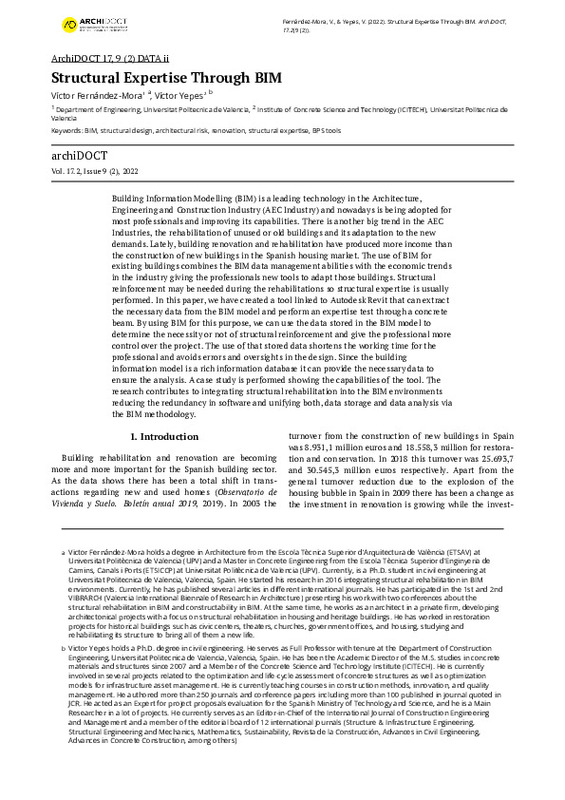JavaScript is disabled for your browser. Some features of this site may not work without it.
Buscar en RiuNet
Listar
Mi cuenta
Estadísticas
Ayuda RiuNet
Admin. UPV
Structural Expertise Through BIM
Mostrar el registro sencillo del ítem
Ficheros en el ítem
| dc.contributor.author | Fernández-Mora, Víctor
|
es_ES |
| dc.contributor.author | Yepes, V.
|
es_ES |
| dc.date.accessioned | 2022-11-29T19:02:28Z | |
| dc.date.available | 2022-11-29T19:02:28Z | |
| dc.date.issued | 2022-02-15 | es_ES |
| dc.identifier.uri | http://hdl.handle.net/10251/190335 | |
| dc.description.abstract | [EN] Building Information Modelling (BIM) is a leading technology in the Architecture, Engineering and Construction Industry (AEC Industry) and nowadays is being adopted for most professionals and improving its capabilities. There is another big trend in the AEC Industries, the rehabilitation of unused or old buildings and its adaptation to the new demands. Lately, building renovation and rehabilitation have produced more income than the construction of new buildings in the Spanish housing market. The use of BIM for existing buildings combines the BIM data management abilities with the economic trends in the industry giving the professionals new tools to adapt those buildings. Structural reinforcement may be needed during the rehabilitations so structural expertise is usually performed. In this paper, we have created a tool linked to Autodesk Revit that can extract the necessary data from the BIM model and perform an expertise test through a concrete beam. By using BIM for this purpose, we can use the data stored in the BIM model to determine the necessity or not of structural reinforcement and give the professional more control over the project. The use of that stored data shortens the working time for the professional and avoids errors and oversights in the design. Since the building information model is a rich information database it can provide the necessary data to ensure the analysis. A case study is performed showing the capabilities of the tool. The research contributes to integrating structural rehabilitation into the BIM environments reducing the redundancy in software and unifying both, data storage and data analysis via the BIM methodology. | es_ES |
| dc.language | Inglés | es_ES |
| dc.publisher | European Network of Heads of Schools of Architecture | es_ES |
| dc.relation.ispartof | Archidoct. The e-journal for the dissemination of doctoral research in architecture | es_ES |
| dc.rights | Reserva de todos los derechos | es_ES |
| dc.subject | BIM | es_ES |
| dc.subject | Structural design | es_ES |
| dc.subject | Architectural risk | es_ES |
| dc.subject | Renovation | es_ES |
| dc.subject | Structural expertise | es_ES |
| dc.subject | BPS tools | es_ES |
| dc.subject.classification | INGENIERIA DE LA CONSTRUCCION | es_ES |
| dc.title | Structural Expertise Through BIM | es_ES |
| dc.type | Artículo | es_ES |
| dc.rights.accessRights | Abierto | es_ES |
| dc.contributor.affiliation | Universitat Politècnica de València. Escuela Técnica Superior de Ingenieros de Caminos, Canales y Puertos - Escola Tècnica Superior d'Enginyers de Camins, Canals i Ports | es_ES |
| dc.description.bibliographicCitation | Fernández-Mora, V.; Yepes, V. (2022). Structural Expertise Through BIM. Archidoct. The e-journal for the dissemination of doctoral research in architecture. 17(9):1-9. http://hdl.handle.net/10251/190335 | es_ES |
| dc.description.accrualMethod | S | es_ES |
| dc.relation.publisherversion | https://archidoct.scholasticahq.com/article/32279-structural-expertise-through-bim | es_ES |
| dc.description.upvformatpinicio | 1 | es_ES |
| dc.description.upvformatpfin | 9 | es_ES |
| dc.type.version | info:eu-repo/semantics/publishedVersion | es_ES |
| dc.description.volume | 17 | es_ES |
| dc.description.issue | 9 | es_ES |
| dc.identifier.eissn | 2309-0103 | es_ES |
| dc.relation.pasarela | S\455419 | es_ES |






